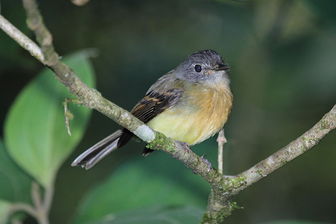Tawny-chested Flycatcher
It is an uncommon inhabitant of mature evergreen forest and tall secondary growth, usually in dense understory vegetation on the woodland edges, along streams, in natural clearings, or in cacao plantations. The nest is built by the female in a natural cavity or a woodpecker hole in a tree or bamboo up to 6 m above the ground. The eggs are undescribed, but tyrant flycatchers typically lay two eggs which are incubated by the female for 15-16 days to hatching,

Original source: Dominic SheronyPermission(Reusing this file)This image, which was originally posted to Flickr.com, was uploaded to Commons using Flickr upload bot on 07:38, 30 May 2011 (UTC) by DreamOfShadows (talk). On that date it was licensed under the license below.Camera location
Author: Dominic SheronyPermission(Reusing this file)This image, which was originally posted to Flickr.com, was uploaded to Commons using Flickr upload bot on 07:38, 30 May 2011 (UTC) by DreamOfShadows (talk). On that date it was licensed under the license below.Camera location
The Tawny-chested Flycatcher is classified as Vulnerable (VU), considered to be facing a high risk of extinction in the wild.
The Tawny-chested Flycatcher is 12 cm long, weighs 7 g and looks like a colourful Empidonax flycatcher in size and structure . It has a grey head with a white throat and white spectacles. The upperparts are olive-green , and the wings are dusky with two bright ochre wing bars and ochre edging to the secondary feathers. The breast is ochre-orange, becoming bright yellow on the belly. Sexes are similar, but females may have an olive tint to the grey head. More
| Tawny-chested Flycatcher in English Use Babylon to translate to various languages Copyright © 1997-2007 Babylon. More
Tawny-chested Flycatcher Aphanotriccus capitalis 2009 IUCN Red List Category (as evaluated by BirdLife International - the official Red List Authority for birds for IUCN): Vulnerable Justification This species has a small range in which forest has been extensively cleared and fragmented. Despite inhabiting edge environments and even nesting in human-modified habitats, it appears intolerant of forest fragmentation, suggesting that it is declining. More
Tawny-chested Flycatcher: This flycatcher is categorized as Vulnerable by Birdlife International (2006 IUCN Red List Category) due to its occurrence being restricted to a small range of increasingly fragmented forest. This species breeds regularly at Rancho Naturalista and it is here that is the best place in the world to see it. More
Tawny-chested Flycatchers, as most species have just finished breeding at the beginning of June there seems to be an abundance of birds present. The Tawny-chested Flycatcher is a very local bird and is found regularly in the grounds of Rancho. We progressed further into the forest where we were met with pairs of Collared, Violaceous and Black-throated Trogons as well as White-collared, White-ruffed and White-crowned Manakin males, Eye-ringed Flatbill and Black-headed Tody-Flycatcher. More
Tawny-chested Flycatcher (Aphanotriccus capitalis) by Robin Carter. More
Family : Tyrannidae
Genus : Aphanotriccus
Species : capitalis
Authority : (Salvin, 1865)

